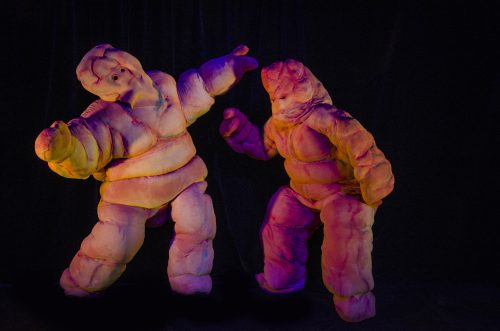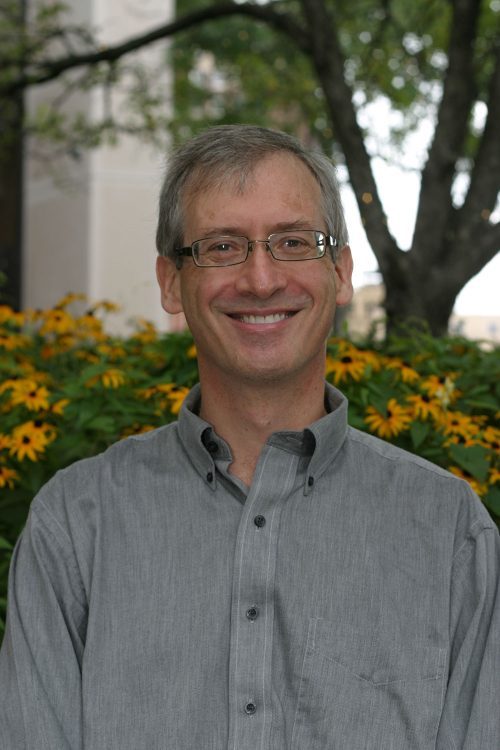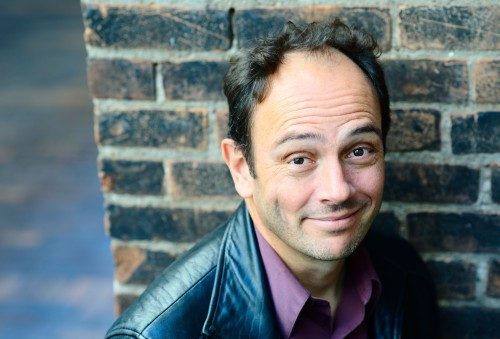By Dan Gross
Don’t Blame Anyone is the first opera by Eastman faculty members to premiere at Kodak Hall in 60 years. This piece combines music, puppetry, dance, and theatre into a two-act opera, and is a collaboration of performers from the United States and Mexico. (It will also be performed at Teatro Diana in Guadalajara, Mexico on November 24.) The Eastman School of Music’s BroadBand Ensemble has joined forces with El Arte de los Titeres, Secretaria de Cultura (Mexico), Universidad de Guadalajara (Mexico), and PUSH Physical Theatre to produce a spectacular performance that explores the birth, growth, and eventual death of the elusive “creative idea.”
The music is composed by Eastman’s award-winning composers Ricardo Zohn-Muldoon and Carlos Sanchez-Gutierrez, and the production features life-size abstract puppets designed by Antonio Camacho and Olga Gamez of La Coperacha, one of the oldest theater groups in Mexico, as well as performances by the physical illusionists of Rochester’s PUSH Physical Theatre. The groups come together on stage to represent a variety of characters: from “ideas in the making” to a human staircase. PUSH Physical Theatre Artistic Director Darren Stevenson developed the opera’s original choreography.
Original drawings by internationally acclaimed Mexican illustrator/cartoonist José Ignacio Solórzano (“JIS”) were created to inspire the performance’s imaginative concept, with puppetry design and narrative inspiration drawn from celebrated aphoristic Mexican poet Raúl Aceves. Famed soprano and new-music pioneer Tony Arnold plays the leading role as “The Author,” who toils to create a significant work as she faces the specter of the blank page.
Don’t Blame Anyone premieres in Kodak Hall at Eastman Theatre on Wednesday, November 16, at 8 p.m. Follow the link at the end of the post for ticket information.
Dan Gross interviewed the composers of Don’t Blame Anyone, Carlos Sanchez-Gutierrez and Ricardo Zohn-Muldoon, on November 7. We are presenting a two-part abridged version of this interview on our blog.
Earlier in the interview, we used “opera” to describe Don’t Blame Anyone. Without putting yourself into a box, what does that mean in terms of the work, and what can the audience expect?
RZM: I think it means that there will be a lot that is familiar, in the sense that there are musicians, singers, and actors. What is unusual here is that there is a very fluid relationship between the different parts, so that the singer can be acting or just singing; that is they can just be part of the ensemble. The PUSH performers will be representing what the singer is saying, or representing something else, as the puppets do.
But it’s really concert music. It’s a kind of music that, if you took it out of the stage setting, you could listen to and enjoy for its own sake. It’s music that deals with the types of concerns that we’ve had, as Carlos said, for years, integrating our own influences, which are varied. There are folkloric influences, there are classical influences…
But ultimately there is a lot for audience members to ground themselves with, in the sense that’s much more progressive than a conventional opera would be. It plays with fantasy at its very core, and even the way the “opera” unfolds is surprising, because we’re trying to put people through what the process of creating an art work is about.
It’s like that drawing of Escher’s where the hand is drawing itself. It’s like that, you’re seeing an opera being made for you, and experience what the author is experiencing, but it’s composed. It’s all an illusion, but we were really trying to do justice to the music.
It’ll be fun.
I love these autobiographical touches to this story. Going to the puppetry, it has this Guillermo del Toro look. It’s so fantastical. How did these designs come about?
CSG: JÍS gave us these designs from quite a number of drawings. Based on those, Antonio and his team built the puppets pretty much on their own. Some of these puppets we didn’t see until last week, which is fantastic, and I just saw them for the first time this morning. I touched them, and they’re terrific, phenomenal.
So, yes, Ricardo was working on the music on his own, I was working on mine on my own, and Antonio and his team were working on the puppets, all while having a conversation of course, we were all talking in some way.
RZM: And we traveled to Mexico together –
CSG: Yes; I don’t want your audience to get the impression we were completely incommunicado, we were not. We were having that conversation, except that we were working on our own craft, because that’s what we do well.
But at the same time, I think the visual influences that Antonio and Olga have in Mexico, the imagery that they have, and the imagination that they possess, are similar to Ricardo’s and mine. They live in the same town; JÍS is someone we’ve all known for a long time, many years. Ricardo, you’ve known him for all your life basically.
So I think we connect not just with he draws, but what he’s interested in the first place, because we spent our teen years with him, and looking at the same things, and watching the same movies… I think it’s that we’re product of a generation, in the city of Guadalajara, who more or less have stayed together creatively. By the way, Guillermo del Toro is a member of that generation, and we knew him well, we used to hang out together.
Guadalajara is a particular kind of town – now it’s a huge city – it’s a city that has produced, for centuries, artists with their particular art and vivid imagination. Great literary figures, great artists, perhaps the best visual arts that Mexico has produced are from the Guadalajara area. Many filmmakers. It’s an intensely creative city that is at the same time very conservative, and very complicated, provincial… I think we all share in this concoction.
It sounds like this project and this type of collaboration is very natural to both of you.
CSG: It is.
This has been a whirlwind project, and a pet/personal project; you’re even bringing it to Mexico. What are some things that you two are feeling?
RZM: There are a lot of feelings. One was panic. But also it has been a great sense of satisfaction. I think Carlos masterminded this, and organized the whole thing… He has handled the many, many, many logistical issues in dealing with teams that aren’t even in the same city.
But I think part of what we were talking about earlier, that it’s very autobiographical, ultimately. Over the years, Carlos and I have had a lot of conversations about the nature of creating and the struggle of expression, this very difficult thing it is to compose music. Then when you see that people in the other arts also have to deal with this problem, but their kind of imagination is so different…
So for me, a true collaboration in this case came from asking ourselves a very difficult question, and then trying to come up with an answer that was worth sharing, because not all things are worth sharing. You can do a lot of things in your studio that aren’t worth sharing with anybody. But we were very interested in what we could come up with when we put ourselves on the line to look at the actual struggle of creativity. Not the finished product, where you are very sure of something and put it out on display, but what one goes through; and that will come through in the show.
There is a long history to that, because I’ve known Carlos for thirty or four years by now. This has been a constant discussion in different guises as we went through school. It marks a cycle of us getting up together and providing some kind of answer to this.
CSG: It’s curious because it shouldn’t be surprising that Ricardo and I understand each other that way, because we have talked about this for a long time. But then, we come across somebody like Darren from PUSH, who gets us right away. We start talking right away, and he immediately understands what we were trying to say, but he brings a very original different perspective on it that is still fundamentally connected to what we do. It’s magical.
I could say the same thing about JÍS, because though we grew up together and knew him very well, we’ve been in the states for thirty years, and we’ve only collaborated with him sporadically. But we had a Skype conversation with him for this project, and he immediately got it, and understood what we trying to stay and came up with some very concise and direct ideas.
This was quite a discovery, that we are all thinking about the same things, and we all found solutions to this problem that are unique and interconnected. That’s the magic in this project, and it’s what’s kept me going throughout in spite of all this ridiculous hard work, red tape, and kinds of issues, because it’s been a tremendous, tremendous ordeal the way we did it. We’re professionals, but not a company.
It’s been very challenging, but at the same time exhilarating.
Don’t Blame Anyone premieres in Kodak Hall at Eastman Theatre on Wednesday, November 16, at 8 p.m. Follow this link for ticket information.


